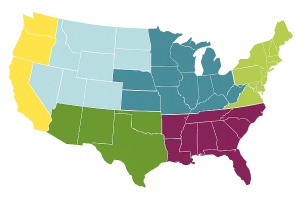How to Grow Hardy Hibiscus Perennials
Posted By American Meadows Content Team on Jul 6, 2015 · Revised on Sep 5, 2025

Knowing your location helps us recommend plants that will thrive in your climate, based on your Growing Zone.
Posted By American Meadows Content Team on Jul 6, 2015 · Revised on Sep 5, 2025
Hardy Hibiscus thrives best in well drained soil, amended with organic matter. Hibiscus prefers acidic soil. To add acidity to your soil, add Peat moss or potting soil to your garden. If your soil is mostly clay, consider planting Hibiscus in a raised bed, this helps to eliminate water buildup. The best time to plant Hardy Hibiscus is after all danger of frost has passed. To plant, dig a hole double the size of the pot and set the plant in, the crown of the plant should rest just at or above the soil surface. Press the new loose dirt around the plant and water. If you water and the base of the plant shows, add more soil. If you are planting multiple Hibiscus, space plants 2 to 3 ft apart in the garden. Although the plant maybe small, these beauties reach 48” – 72” Tall.
Hardy Hibiscus is slow to emerge in cold springs or early summers, so be patient. Hardy Hibiscus does best in full sun. They will grow in partial shade, but growth and flowering will suffer. If you live in areas with very hot summers, during the hottest part of the day, Hibiscus may need shade. Hibiscus should be planted along, or in the back of perennial flower beds.
Hibiscus needs lots of nutrients. There are a few ways to fertilize Hibiscus. One option is in the spring; apply a layer of compost around the base of the plant. Or apply fertilizer with 10-4-12, 9-3-13 or 10-10-10 around the base of the hibiscus. Be careful not to add too much fertilizer, too much phosphorous will kill hibiscus.
Hibiscus is hardy to zone 5. Hardy hibiscus benefits from warm temperatures for bud growth, so if it’s a cold spring or summer, growth will be slower. To keep Hibiscus warm apply a layer of mulch to protect Hibiscus in the winter and early spring.
Hibiscus needs both moist and well drained soil. If Hibiscus dries out to much it will drop all its foliage and will look like a bunch of dead sticks. When this happens don’t stress, it will re-bud, it’s the Hibiscus protecting its roots system. It’s important to not over water or underwater. If you are growing hibiscus in a container, plant your hibiscus in a pot with adequate drainage holes. Otherwise if Hibiscus is in water to long, its root will begin to rot.
Hibiscus don’t need to be pruned, but you may choose to shape Hibiscus by cutting back old growth in late fall or winter depending on your location. Otherwise Hibiscus produces new growth every year from the ground up. To encourage branching and more flower stalks, prune in early summer when Hibiscus has started to grow.